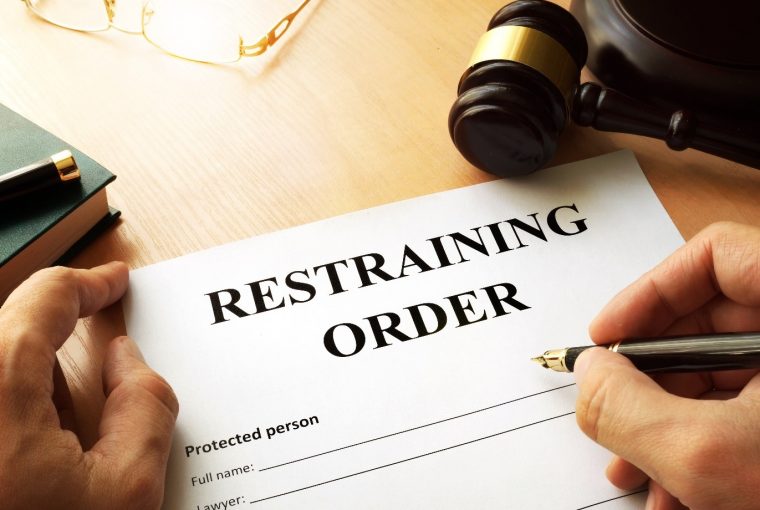Background checks are not uncommon. Most jobs in the United States require some form of background check during the hiring process, even if it’s a simple social security number (SSN) verification. Background checks give employers insight into whether or not a candidate is a good fit.
Many people are concerned about what turns up when it comes to background checks. Fortunately, knowing what shows up on a background check before you go through one will help you succeed.
If you’re curious about whether or not a restraining order shows up on a background check, you’re in the right place. We’ll take you through everything you need to know to help you prepare.
What Is a Restraining Order?
An order of protection, or restraining order, limits the contact between one party and another party. Typically, restraining orders prevent people from speaking to people or being within a specific distance of someone. For example, someone might have a restraining order that prevents them from going within 100 feet of someone.
Restraining orders are issued by the court and may last for several days, months, or even years. Because restraining orders are issued by courts, there are records of them and they stick with people for many years. The nature of a restraining order depends on crimes committed, harassment, violence, intent, and other factors.
Are Restraining Orders Criminal Charges?
Restraining orders aren’t always criminal charges. A regular restraining order may be issued as something like a violation or misdemeanor. However, some restraining orders are in place as a response to criminal charges. So, someone can file criminal charges along with a restraining order. In these cases, the court case and criminal proceedings will be present in a background check.
When Does a Restraining Order Become Criminal?
Restraining orders will also become criminal charges when violated. Therefore, if someone violates the terms of a restraining order, it becomes a criminal matter and will appear on a criminal record. Fortunately, many restraining orders explain what you can and can’t do. Therefore, following the guidelines within the order of protection will prevent the restraining order from becoming a criminal matter.
What’s a Background Check?
Background checks occur when an employer or agency wants to assess someone’s public records. These checks present employers or agencies with criminal records, credit history, and much more. A background check aims to verify someone’s identity and learn more about them. Today, background checks are required for most professional jobs and even in military service.
There are also several types of background checks. Common background checks include criminal background checks, employment verification, education verification, and social security number verification, and restraining orders will most likely appear on a criminal records background check.
Do Restraining Orders Show Up on Background Checks?
Restraining orders will show up on some background checks but not on others. Whether or not a restraining order shows up depends on several factors. These factors include the type of background check, the nature of the restraining order, and what kind of job someone is applying for.
For example, military background checks are more in-depth and will reveal sealed court documents – including a restraining order.
On the other hand, a more general background check typically won’t reveal a restraining order. So if a company is simply verifying someone’s identity, there’s a good chance you don’t have to worry about the restraining order coming up.
How Do You Know if a Restraining Order Will Show Up on a Background Check?
It’s possible to know before a background check if a restraining order will show up. The best way to determine if the restraining order will appear is to perform a public record search on yourself. A background check consists of a collection of public records; if you can find it, so can an employer.
To perform a public records search on yourself, Information.com is the best place to start. Information.com has a criminal and public records search tool that allows you to view public information about yourself. Simply enter your name into the search tool and open the full report.
If the restraining order appears in your public records report, there’s a good chance it will show up during a background check.
What Else Shows Up on a Background Check?
Restraining orders can show up on background checks, but that’s not the only available information. In fact, background checks will reveal a lot of information about someone. This is why they’re so common among employers.
Background checks will typically show employers the following:
- Court records
- Criminal records
- Jail sentences
- Traffic violations
- SSN verification
- Social media profiles
- Dating profiles
- Email addresses
- Primary and secondary addresses
- Past addresses
- Phone numbers
- Marriage documents
- Family members
- Work experience
- Education background
- Military service
Depending on the situation, background checks may reveal none or all of this information. Also, keep in mind that employers can’t run a background check without your consent. If you don’t feel comfortable, you can apply elsewhere.
And remember, an employer cannot perform a background check on you without your expressed written consent first.
Final Words
Restraining orders are a part of life for millions of Americans. The good news is that you don’t have to let it hold you back, especially if the restraining order came about for nefarious reasons. That said, it’s always best to be prepared. Before a company or government agency runs a background check on you, be proactive and run a people search on yourself first.
Knowing if a background check will reveal a restraining order gives you time to prepare an explanation. It’s always better to be prepared rather than surprised.
- Online vs Offline Casinos: The Pros and Cons - April 24, 2024
- Top Reasons to Play at Online Casinos in Australia - April 24, 2024
- Serving Aces and Placing Bets: A Beginner’s Guide to Tennis Betting - April 22, 2024









